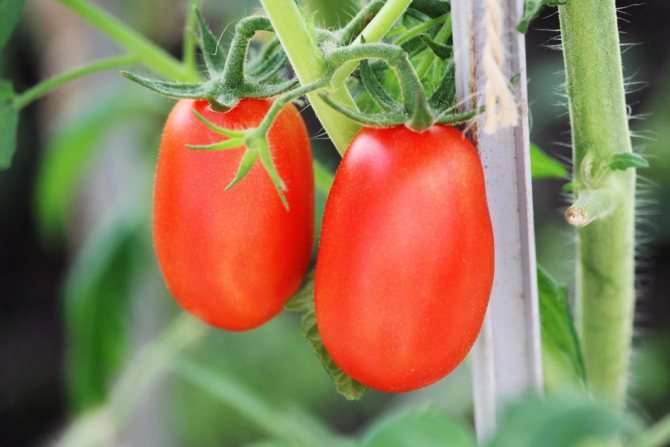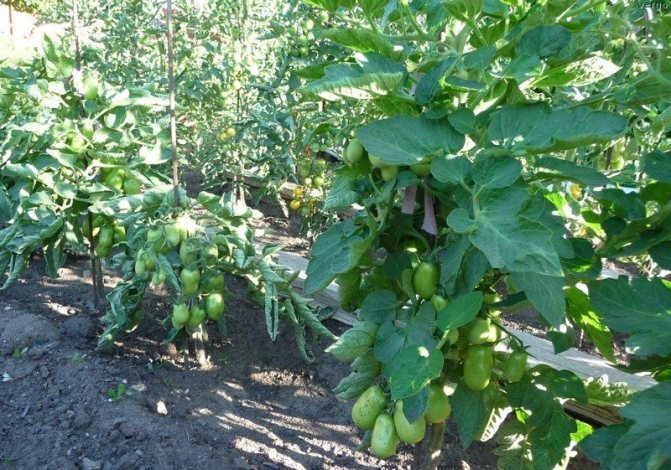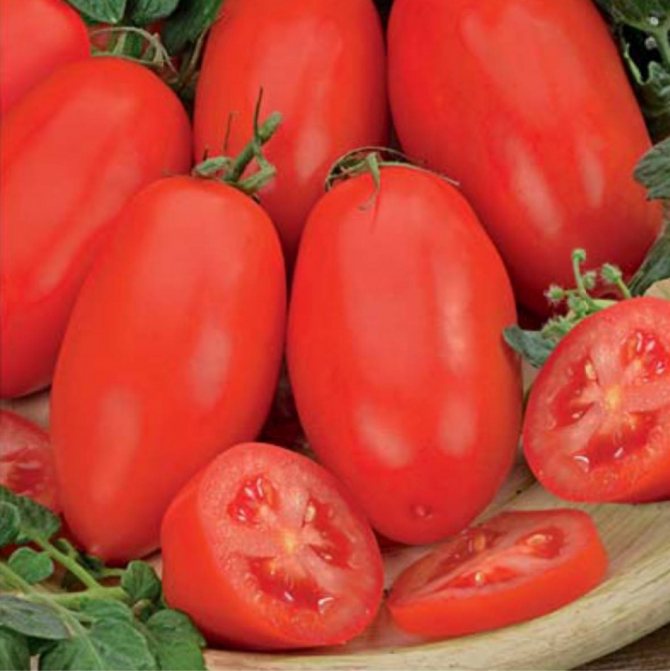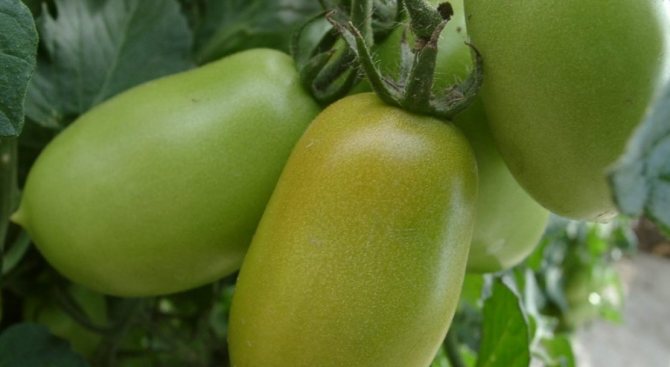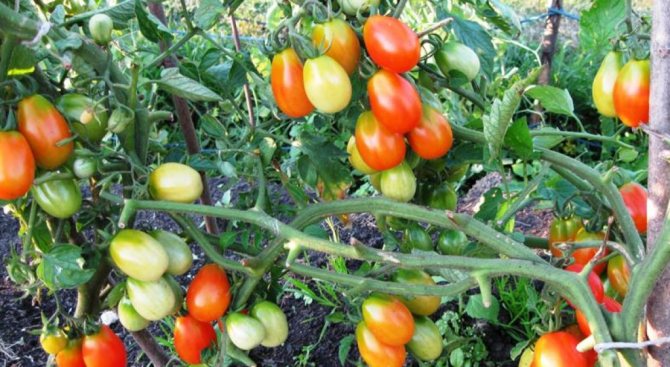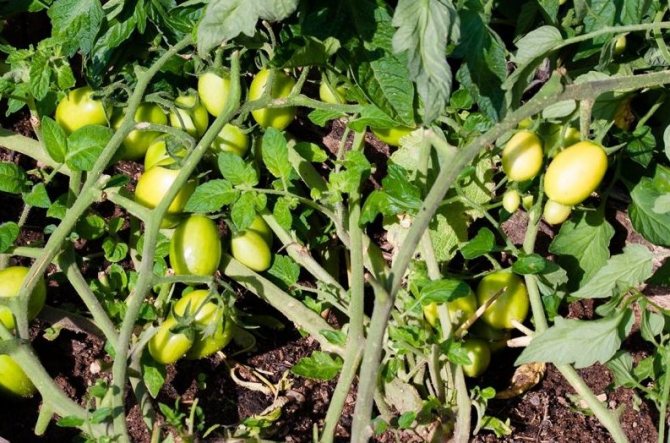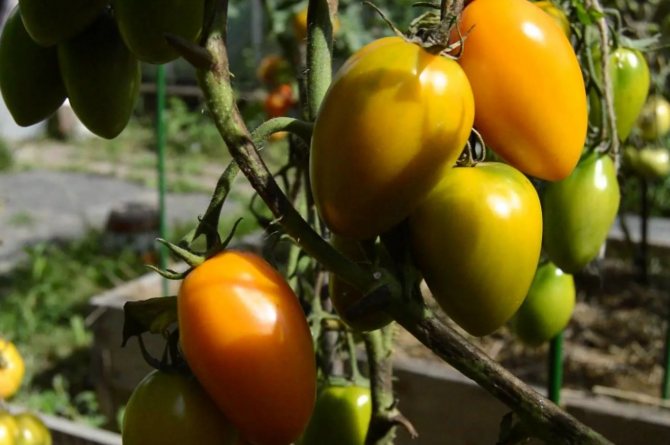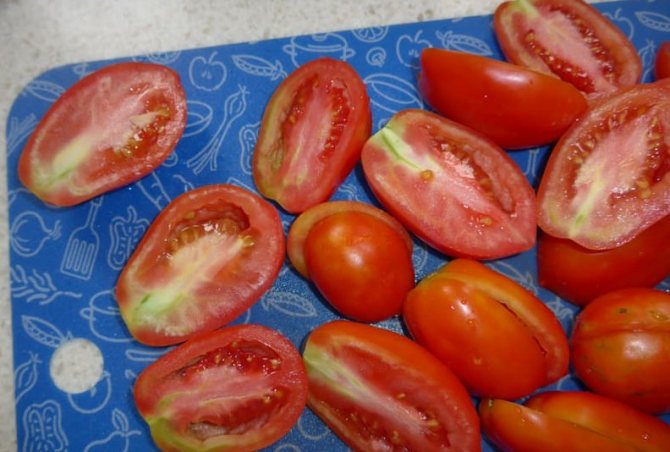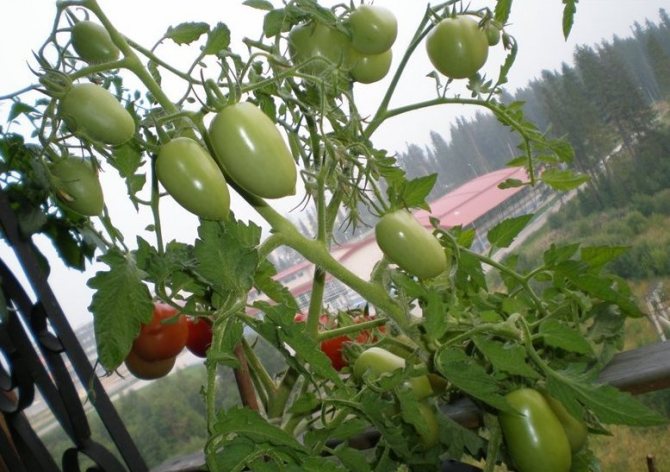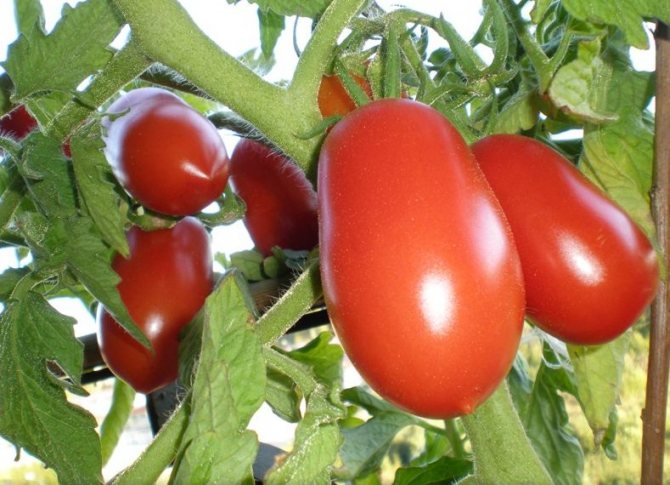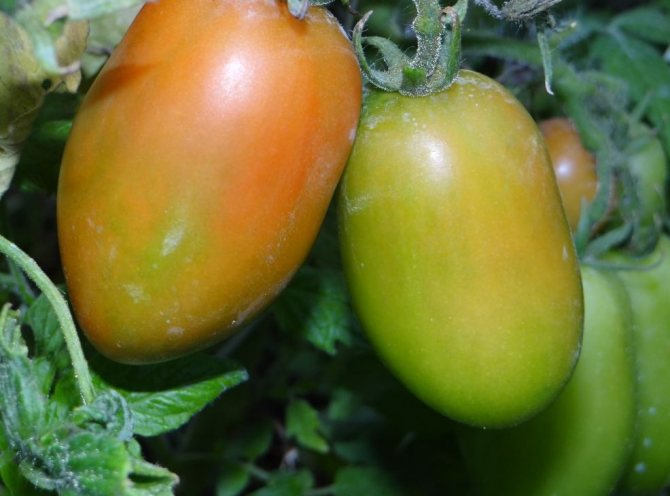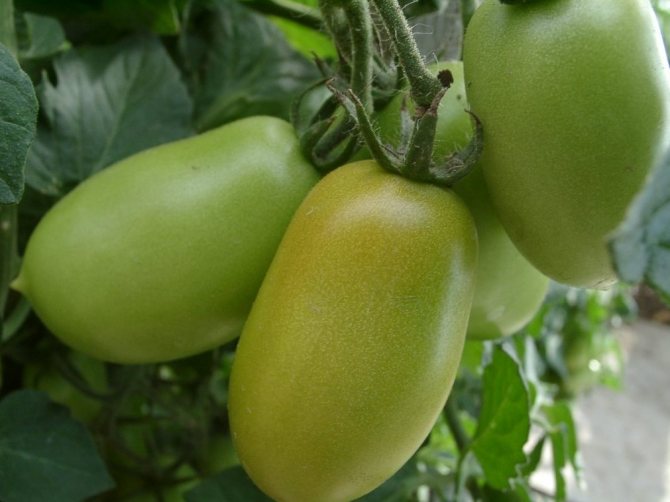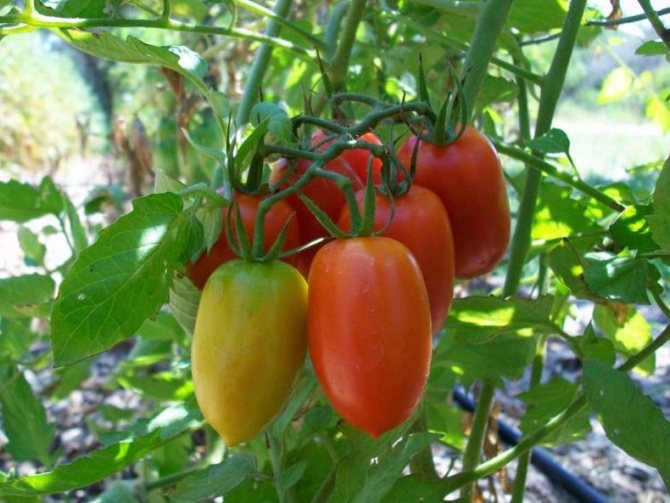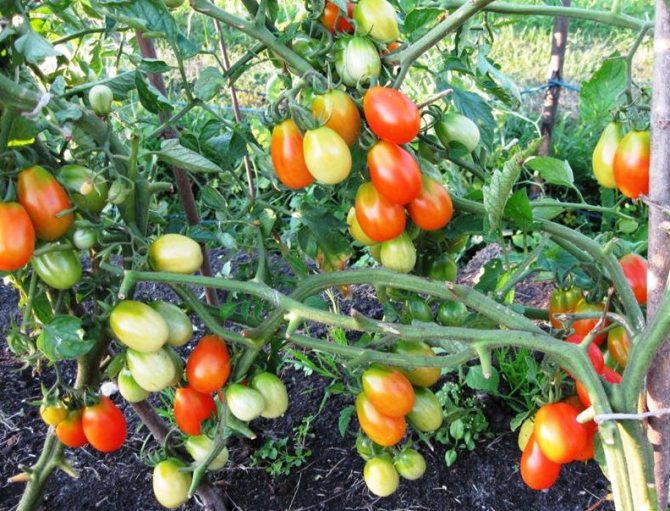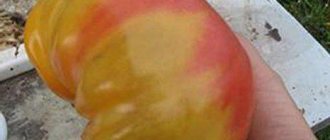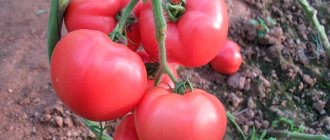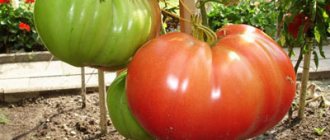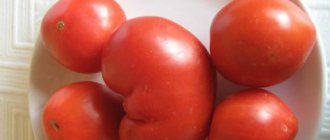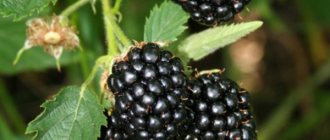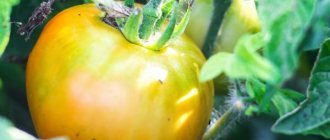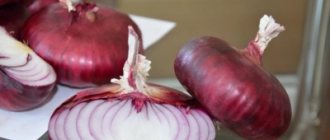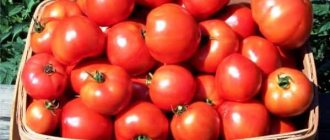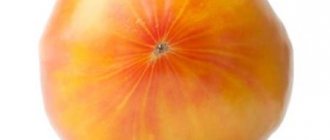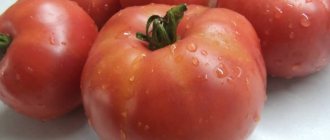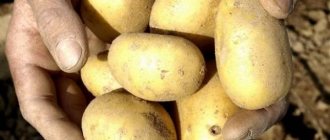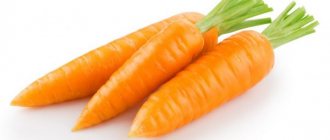»Vegetable» Tomatoes »Description of the tomato Shuttle
0
235
Article rating
The Tomato Shuttle is in great demand among gardeners in our country: it is unpretentious in care, resistant to low temperatures and gives a rich harvest. Subject to all the rules of agricultural technology, you can successfully grow this crop in your area.
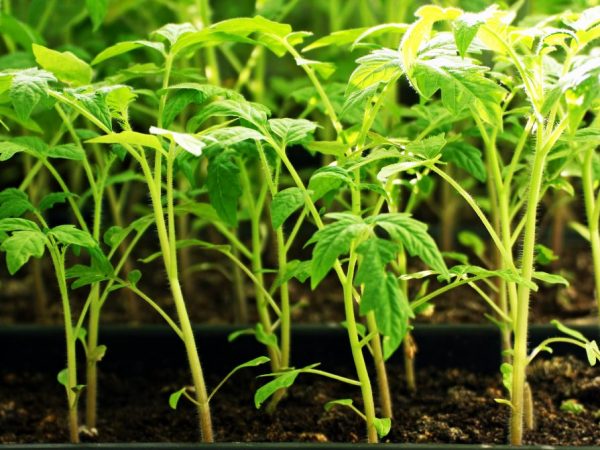
Description of Tomato Shuttle
Features of the variety
Tomatoes of the variety "Shuttle" refers to early ripening. Determinate bush, standard type and compact size - up to 50 cm in height.
Shoots are erect, slightly leafy, do not need pinching. On one fruit branch, from 6 to 10 ovaries are formed, which ripen at different times and throughout the entire summer period.
The fruits are elongated cylindrical in shape, outwardly very similar to pepper. Pointed tips. Average weight - 50-60 g. The skin is dense, glossy.
The pulp is juicy and sweet. Due to the high content of useful and nutritious substances, tomatoes of this variety are especially necessary for children.
():
The declared average fruit weight of 50-60 g is obtained only if the plants of this variety are grown in a high agricultural background, with insufficient nutrition, the fruits are very small.
Detailed description
The variety "Chelnok" was obtained by Russian breeders and zoned for the southern and central regions of the country. It is intended for open ground, but if necessary, it can successfully grow and bear fruit in a greenhouse or under a film cover. Some experimental gardeners grow the "Shuttle" and in room conditions, setting large pots on the windowsill or on the glassed-in balcony.
Bushes of the "Shuttle" variety are determinant, of the standard type. Their height does not exceed 50-60 cm. Such undersized plants have a reliable, stable stem. On it, in a small amount, stepsons and leaves are formed, which must be periodically removed as they grow. In general, the standard bush does not require enhanced formation, since it independently regulates its growth. Such self-regulation saves the farmer's time and is one of the advantages of the "Chelnok" variety.
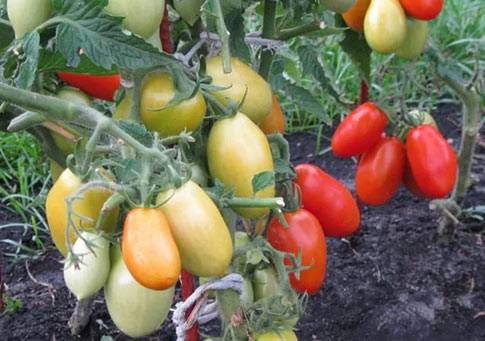

Tomatoes "Shuttle" form fruiting clusters above 6 leaves. On each of them, 6-10 simple flowers are formed at once. If you want to get larger fruits, pinch the brushes, leaving only 4-5 ovaries. They are especially well loaded with nutrients and juice, resulting in large-fruited tomatoes. If you do not pinch the fruiting brushes, then the result can be a large number of medium-sized tomatoes. An example of such fruits can be seen above in the photo.
All about the Tomatoes "Shuttle"
The shuttle tomatoes have a cylindrical shape. A small pointed "nose" may form at their tip. The color of tomatoes at the stage of maturity is bright red. Vegetable skins are firm and resistant to cracking. When eating vegetables, tasters note its some roughness. You can evaluate the external characteristics and description of the "Shuttle" tomato variety by looking at the photos offered in the article.
The average weight of “Shuttle” tomatoes is 60-80 g. If desired, by removing a certain number of ovaries, you can get tomatoes weighing up to 150 g.It should be noted that such a mass is a record for ultra-early ripening tomatoes, which include the "Shuttle" variety.
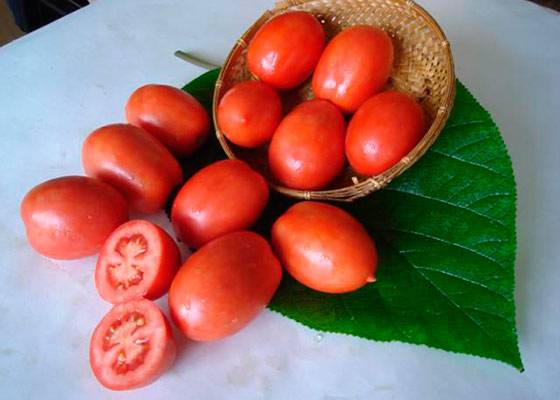

Experts estimate the taste of the Chelnok variety as high. Tomatoes have a firm flesh with 2-3 seed chambers. The pulp harmoniously combines light sourness and high sugar content. The aroma of vegetables is not very pronounced. Tomatoes can be used for making fresh snacks, cooking and preserving. Tomatoes produce thick juice and pasta. After processing and canning, vegetables retain their sweetness and unique flavor.
Important! The large amount of sugar makes it possible to use tomatoes in baby food.
Productivity and ripening period
Tomatoes "Shuttle" are ultra-early ripening: it takes about 90-120 days to ripen. Such a relatively short ripening period of vegetables makes it possible to use the variety for obtaining the first vegetables for salad purposes. You can grow the first ultra-early ripening tomatoes in a greenhouse. In general, it is rational to place seedlings of tomatoes of the "Chelnok" variety in open beds, since for protected conditions it is recommended to use high-yielding indeterminate varieties of unlimited growth.
Important! Ripening of “Shuttle” tomatoes is long and lasts until the first frost.
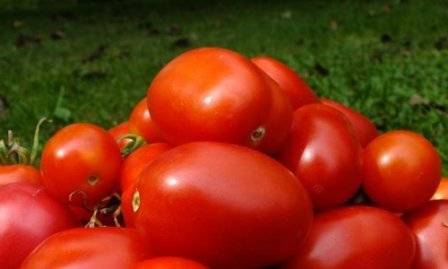

The yield of the variety "Chelnok" depends largely on the cultivation conditions. Growing a variety in a greenhouse, you can get about 10 kg of vegetables from 1 m2 of soil. On open beds, the yield can drop to 6-8 kg / m2. To get a lot of vegetables, it is also important to follow the growing rules.
Disease and pest resistance
Unfortunately, with all the wonderful characteristics and description of the variety of tomatoes "Shuttle", the culture has no protection from diseases and pests. To prevent the development of ailments, special attention should be paid to preventive measures. So, before sowing, tomato seeds and the soil must be treated with a manganese solution or a solution of copper sulfate. These substances will remove fungi and viruses that can cause some specific diseases.
Such a well-known and widespread disease as late blight can affect plants in conditions with high humidity and low air temperatures. To prevent late blight, tomato bushes can be sprayed with garlic infusion or special preparations (fungicides). When favorable conditions are established for the spread of late blight, it is necessary to carry out preventive treatment 1 time in 3 days.
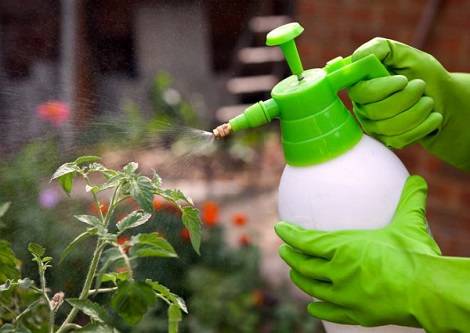

The causative agents of viral diseases often hide in the ground, so tomatoes should be planted in the place where the so-called favorable predecessors (carrots, cabbage, legumes, greens) used to grow. It is not recommended to plant tomatoes in a place where nightshade crops used to grow.
Preventive plant protection measures allow you to fight pests. So, it is recommended to regularly weed the ridges and mulch the near-stem circle of tomatoes with peat or straw. Regular inspection of plants will allow you to detect pests before they spread massively. In the fight against insects, you can use natural folk remedies, biological and chemical substances.
Important! Iodine, milk whey and laundry soap are highly effective in combating diseases and pests.
Dignity
According to the characteristics, the Tomatoes Shuttle have the following advantages:
- suitable for planting in both open and protected beds;
- early maturity;
- universal use - vegetables are consumed fresh, and also used for preparing various dishes, preparations for the winter (canning, pickling, pickling);
- a long period of fruiting - the beginning of ripening occurs in mid-July, and the end of the harvest in the last decade of October;
- thanks to compact bushes, it is possible to significantly save space in the garden for other plants;
- good resistance to cold weather and sudden temperature changes, which makes it possible to grow a crop not only in the south, but also in regions with a cooler climate;
- high immunity against phytophthora;
- the variety is small-fruited, so vegetables are great for winter preparations in small containers;
- good yield, subject to all the rules of agricultural technology: up to 10 kg / m²;
- excellent taste, marketability and transportability.
Tomatoes Shuttle on video
If you have grown shuttle tomatoes, please write whether you like them or not. What was the yield and taste of the fruit in your climatic conditions? How do you rate the resistance of this variety to diseases and pests? Describe briefly what, in your opinion, are the advantages and disadvantages of this tomato. If possible, attach a photo of the entire bush or individual fruits grown by you to the comment. Thank you!
Your reviews about the Tomato Shuttle and additions to the description will help many gardeners evaluate this variety objectively and decide whether to plant it or not.
This is a natural tomato variety. Therefore, we recommend taking seeds from a ripe fruit and using them for planting in the following seasons.
Site about tomatoes - Tomatland.
Buy tomato seeds Cornabel
Russia Gardens
Hit of the season 2020! A novelty that has shown a stunning result! High yield! Great fruit taste!
The subtleties of growing
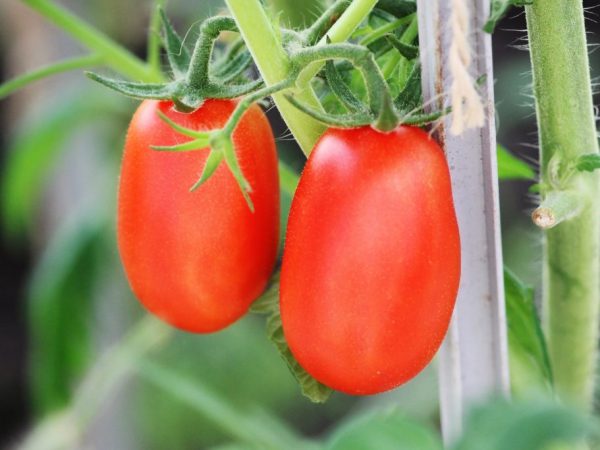

Great yield when properly prepared
There are two ways of growing - seedling and seedling. The first method is often used in regions with warm climates.
Those who planted this crop in the North or in the Middle Lane claim that you can get a tasty harvest only when grown through seedlings.
Seed preparation and sowing
Before sowing, the seeds should be prepared:
- First, they undergo a disinfection procedure in a solution of potassium permanganate - 2 g of the substance are used per 1 liter of water. Soaking time - 10 minutes, solution temperature - 40 ° C.
- To accelerate the germination process, growth stimulants are used - Epin or Zircon.
- The seeds are wrapped in a well-dampened cloth and placed in a plastic container. The container is covered with a lid, but not completely so that the seeds do not suffocate. It will take about two days to hatch. During this time, they need to be periodically sprayed.
Capacity
You can sow seeds in seed boxes or plastic containers. Some people use peat pots or disposable cups to avoid picking in the future.
Before planting, the container is spilled with a raspberry solution of potassium permanganate to protect crops from infection with various infections.
Priming
Tomatoes love to grow in light, loose and neutral soil - the optimal pH level is 5.5-6.0.
For sowing, a ready-made store-bought mixture is used; you can also prepare a nutrient composition at home by mixing humus, black soil, sand and vermiculite in proportions of 2: 1: 1: 0.5.
Timing
The optimal sowing time is the end of February or the beginning of March. Such deadlines should be observed for those who wish to get an early harvest (at the end of May or at the beginning of June).
Sowing scheme and rules
The day before sowing, the soil is thoroughly moistened with a spray bottle, the next day it is loosened and leveled.
Depending on the planting container, the seeding pattern will be different:
- when planting in a disposable container, 2-3 seeds are sown;
- when using seedling boxes or containers, grooves are made at a distance of 6-7 from each other.
The optimum planting depth is 1-1.5 cm. Crops are irrigated with warm water, tightened with a film or covered with transparent glass, placed in a warm place with diffused daylight.
Advantages and disadvantages of the variety
The positive features of the variety include the following:
- The Tomato Shuttle is very frost-resistant. It can be planted even in Siberia.
- The bushes are small, compact, because of this, they do not need to be tied up, pinned, cut off excess trunks.
- The skin of the fruit is dense, so tomatoes are easily transported over long distances. Tomatoes are stored for a long time.
- Tomatoes contain a lot of sugar and nutrients, the fruits are suitable for feeding children.
- The variety has an excellent yield.
- The fruits are tasty, fleshy, very sweet.
- Since the bushes are compact, they do not take up much space.
- Quite a long time for fruit formation.
- The variety is unpretentious in care.
There are also disadvantages: The shuttle is not resistant to diseases, and if the weather is cool, much less ovaries are formed.
Features of seedling care
Until the sprouts appear, crops need to be periodically:
- spray - as the top layer of the earth dries up (warm water of 20 ° C is used for irrigation);
- ventilate - at least once a week;
- provide stable heat (25-28 ° С) and humidity at the level of 60-65%;
- in case of insufficient lighting, which is typical when the sprouts are kept on the east or north side of the room, artificial lighting with an LED lamp for at least 8 hours a day will be required.
():
Additional lighting will be required when growing seedlings and on the southern window, because the sun is there only part of the day. Supplementary lighting is especially important for early sowing in late February - early March, when the duration of the day is 7-8 hours, with the need for tomato 12-14 hours.
As soon as sprouts appear, the temperature is lowered to 17 ° C during the day and 13 ° C at night. After a week, the temperature regime for crops is increased to 20 ° C. Such differences are necessary for the seedlings to get stronger and not stretch out.
The picking takes place at the stage of the appearance of a pair of true leaves. The sprouts are planted individually in disposable cups or peat pots. When picking, the root is specially pinched to stimulate the formation of lateral roots. Then watered with warm, settled water.
Disease and pest control
Since the tomato shuttle is not resistant to diseases, renew the top layer of the earth every year. Water the soil with a solution of potassium permanganate or copper sulfate, eliminating fungi.
For the prevention of late blight, it is advised to spray the plants with compounds that contain copper. You can treat the bushes with Bordeaux liquid from mid-June (this is a combination of lime and copper sulfate solutions).
Pluck and burn diseased leaves and fruits. If tomatoes grow in a greenhouse, be sure to ventilate the room so that there is no too humid air.
To grow healthy bushes that do not suffer from viral diseases, observe the crop rotation. Do not plant seedlings in an area where nightshades used to grow. Plant the bushes where there were legumes, herbs, cabbage, carrots.
To prevent the attack of pests, mulch the soil with peat, mowed grass, humus with a layer of 10 cm. Pull the weeds in time.
Examine the bushes regularly, especially the underside of the leaves. If you see the larvae, then collect them and burn them, you can wash the bushes with warm water with soap dissolved in it.
If you see slugs, then collect them, make a solution of ammonia. Spray the bushes with them. If you plant parsley, celery, mint in the aisles, it will scare away harmful insects.
If the tomato variety Shuttle is very severely infested with pests, treat the bushes with insecticides. Reviews strongly recommend processing before the first ovaries appear.
Transfer to the garden
Before planting on the site, the seedlings are gradually accustomed to fresh air - they are hardened on a glassed-in balcony or veranda for several hours a day. The day before the transplant, she is left to spend the night on the street.
Before sampling, the plants are spilled abundantly with water to eliminate the risk of root injury during transplantation.
The transplantation procedure is carried out provided that the soil temperature has reached 12 ° C, and the air temperature is 16-18 ° C.
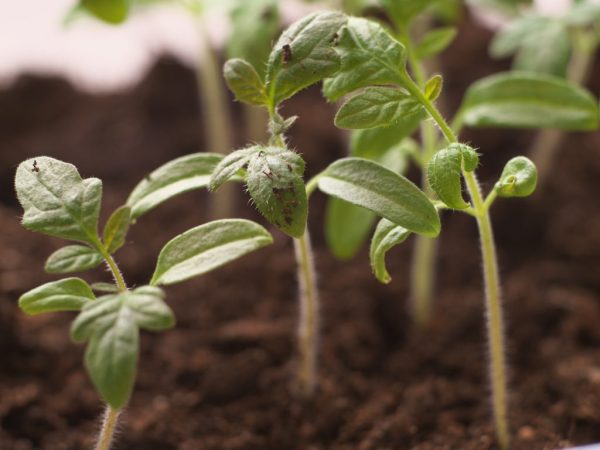

The transplant should be done in a warm ground.
Garden bed preparation
For cultivation of this culture, a sunny and calm place is chosen. The soil is prepared in the fall - they make per m²: a bucket of peat or compost, 1 kg of wood ash and 2 tbsp. l. superphosphate and potassium salt. Then the soil is dug up without breaking up lumps.
Transplant technique
In the prepared area, holes are made at the rate of 4-5 holes per m². The depth and width of the planting pits should correspond to the dimensions of the seedling tank, since the transplant is carried out together with an earthen lump. The distance between the holes is 35-40 cm.
Before disembarking, each pit is spilled with water. Consumption per hole - 1 liter.
A wooden peg is driven in near each bush, which will later serve as a support for an adult plant.
Yield
Fruiting occurs from the second half of June to mid-October. The fruits ripen gradually. For the season, the yield from one bush is 1-1.5 kg. The fruits are of universal importance. They can be eaten fresh (they have a pleasant sour-sweet taste), they are used for winter spins, sauces and juices are prepared.
Due to the sugar content, the fruits of the Tomato Shuttle can be used for baby food. Thanks to their dense pulp, tomatoes can be transported over long distances.
They are very easy to store: at home they can be stored for several days, and tomatoes do not lose their taste and presentation. And when processed with boiled water (during canning), their dense skin does not crack.
Care requirements
- The tomato variety Shuttle tolerates drought well, but with regular moisture, yield indicators increase significantly. Seedlings need moderate but frequent watering after transplanting. The more often you water it, the faster it will take root and grow the underground and aboveground parts. Watering is no less important during the period of ovary formation and fruit filling - the frequency of moistening is at least 2 times a week in a dry summer. The depth of soil moistening at each stage - 20-25 cm is enough for seedlings, 25-30 cm in the fruit-filling phase.Amount of water - for a 1 x 1 m garden bed about 20 liters
- Loosening and weeding. The soil is loosened after each watering to avoid the formation of an earth crust. In the process of loosening, the bed is weeded and freed from weeds and vegetation residues.
- The description of the variety includes a good yield (8-10 kg / m²), but on condition of timely and balanced nutrition. The first feeding is carried out two weeks after picking the tomatoes - they are fed with the drug Kristallon or Nitrofoskoy. Further, the bushes are fertilized regularly every 10 days, using ready-made mineral and organic fertilizers. These can be purchased at a gardening store. 0.1 l of the nutrient liquid composition is consumed per plant.
- Additional processing of the aboveground part is carried out with a solution of boric acid - 0.2 g of powder is dissolved in a liter of water (50 ° C). This improves the flowering and formation of the tomato ovary. Ovary is a good substitute. Irrigation is carried out one month after planting seedlings in open ground.
Planting and leaving
In order to get a crop of tomato "Shuttle", you need to plant them correctly. For most territories of Russia, it is recommended to do this using seedlings, but only in the south is it possible to sow seeds directly into open ground and wait for shoots. Residents of Krasnodar and Astrakhan can afford this option, while the rest need to take care of the preparation of seedlings.
The optimal time for this is March, because before planting in the ground, the seeds go through a two-month cultivation path.If you need to get fruits earlier, and cultivation will take place in a greenhouse, then sowing can also be carried out in February. In this case, it is necessary to provide the plants with good illumination, because in the winter they are greatly lacking in sunlight.
To get good seedlings, you need to prepare the seeds, soil for them and create all the necessary conditions. Work in this direction proceeds as follows:
- It is necessary to prepare the seeds, for which they are calibrated, disinfected and, in some cases, germinated. It is not necessary to carry out all operations if the quality of the seeds exactly meets the standards. In case of doubt, it is better to guide the material through all the above steps, so that only those who are capable of planting are left. You can use seeds that have sprouts of several millimeters at the last stage.
- It is important to purchase or make soil, which will contain a sufficient amount of peat, humus and earth. The optimal ratio will be an equal proportion of each of the components. By mixing all the parts, you can get at least a bucket of composition, into which a handful of ash is added for better growth. In order for the soil for tomatoes to be free of harmful microorganisms, it must be disinfected with a pink solution of potassium permanganate. This option is suitable for self-preparation of the soil. If there is no possibility or desire for this, then it is easier to purchase a ready-made mixture that is completely ready for use.
- Initial planting of seeds, which is carried out in a common box, convenient for use. It can be metal, plastic, or even ceramic, but for greater convenience it is better to use plastic, it is lightweight and inexpensive. In the prepared container, you need to pour soil, the height of which will be more than five centimeters, and make shallow grooves in it, where the seeds will be placed. It is important to moisten the soil, then put one seed at a distance of 2-3 cm. They should be deepened by no more than 1-1.5 cm.
- Compliance with temperature indicators, due to which seeds germinate and begin to turn into seedlings. The box in which the seeds are located must be covered with glass and wait about eight days to get seedlings. When this happened, it is important to lower the temperature to 18 degrees and illuminate the sprouts as much as possible, if possible, place them on a south-facing windowsill. When young sprouts are acclimated and grow, the temperature should be raised to room temperature. This process usually takes a couple of days.
- Planting of plants, which is carried out when the sprout has at least three leaves. If there are cups, it is better to place each bush separately, but if this is not possible, then a large-sized container is taken into which the soil is poured, and the plants are planted at a distance of at least seven centimeters from each other.
- The process of caring for seedlings, which goes until they are planted in open ground. Young tomatoes need to be watered infrequently, but the earth should not dry out. Several times it is worth adding a weak solution of any complex fertilizer. If the plants are growing quickly and well, supplementation is not necessary.
- Preparation for planting, which is carried out with the help of periodic removal of seedlings to fresh air. Usually it should be done a week or two before planting, so that young bushes can get used to the wind and temperature fluctuations.
Planting of “Shuttle” seedlings is carried out when the stems have increased enough in volume, the leaves have a rich color, and the size of the plant does not exceed 25 cm. If there are already several buds before planting, then this will be an additional plus. If cultivation is planned in a greenhouse, then planting in the ground is carried out at a time when the air and soil are well warmed up. The minimum temperature at which a bush can grow normally is 14 degrees, so there is no point in transplanting if there is a risk of frost.In those greenhouses that have heating, it is possible to complete this procedure faster and without the risk of losing seedlings.
When choosing a plot in the garden for planting a tomato, you need to look for a secluded place where there will be no strong winds, but at the same time with constant access to the sun. It is best to prepare the site in advance - during the autumn work, digging up the site and adding the necessary fertilizers to it. The site will need at least a bucket of humus, where a handful of ash and 40 g of superphosphate intervenes, which is very important for the normal growth and fruiting of tomatoes.
It is necessary to plant the bushes quite often, the maximum distance between them should be 40 cm. A small hole for the bush is dug out, fertilizers are introduced into it before planting - from half a glass of ash to a spoonful of nitroammophoska, mixing them with the soil and pouring water. Seedlings are planted with a lump of earth in which they were grown, and they do not deepen much, but only to the lower leaves.
Shuttle tomatoes will grow and yield even with minimal maintenance, but the variety is responsive to attention and care.
Seedling preparation
For such an early ripening and undersized variety, it is very important to choose the optimal sowing time. Overgrown seedlings can bloom even before planting in the ground and not give full-fledged ovaries, and then part of the crop (the first, largest fruits) will be lost irretrievably, and fruiting will be delayed. It is better to transplant in the initial phase of budding or even a little earlier. For the variety "Shuttle", it should take 5-7 weeks from germination to transfer to the garden.
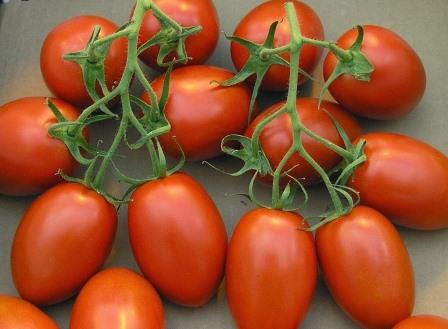

In the conditions of the Russian North-West, the Non-Black Earth Region, the Urals and Siberia, shuttle tomatoes are sown in early April, if it is planned to plant seedlings directly in open ground. For greenhouses, an earlier date is chosen - the second decade of March. The shuttle variety can also be grown in a seedless way.
Since the Tomato Shuttle is a standard tomato, it is not prone to pulling out during the seedling period. Saplings are strong and stocky even from inexperienced vegetable growers.
See also: "Garden Tomatoes: Growing Seedlings".
Landing conditions
Tomatoes Shuttle, being an unpretentious and undersized variety, are intended for outdoor cultivation. By the way, ground tomatoes are healthier and tastier than greenhouse ones, especially if they ripen on the vine. It makes no sense to occupy a high greenhouse with standard plants. Here they are only relevant as a seal along the track.
Read next: Grape Rails Pink Seedlis -
Tomatoes do not develop well and bear fruit on acidic soil. Liming should be carried out in the fall, consuming up to 9 kg of fluffy lime per 10 sq. m with strong soil acidity and half to three times less with moderate. Spring deoxidation (if the procedure is not done in autumn) is carried out with milder deoxidizers - dolomite flour or wood ash.
The beds for tomatoes must be filled with organic matter (5-8 kg of humus per 1 sq. M), wood ash, potassium sulfate and superphosphate, magnesium fertilizers. Tomatoes respond well to mulching.
For 1 sq. m 5-6 plants are appropriate. If minimal care is planned, without pinning and garters, then placement should be more rare (4 pieces per 1 sq. M).
The Tomato Hook is suitable for planting in dense rows with wide row spacing (industrial method). In a row, plants are densely arranged, with a distance of 35 cm between the bushes. At the same time, the row spacing is made at 65-75 cm.
The best results in terms of yield of the Shuttle are achieved with moderate pinching. This can be a one-time procedure. At the moment of flowering of the first brush, all lateral branches (“on a stump”) and shoots growing from the ground (competitors of the main stem) are removed from it. Further pinching should not be carried out, since this will lead to a decrease in the yield: a significant proportion of ovaries are formed on the upper stepsons.
Shuttle tomatoes are responsive to regular watering (better by letting, not sprinkling, so as not to create excessive dampness and provocation of fungal diseases). At the same time, dense fruits are not prone to cracking, therefore they are resistant to irregular moisture.
The shuttle variety is not too susceptible to diseases, and you can get an environmentally friendly harvest from it. To do this, it is necessary to strictly observe crop rotation (in the open field it is easier than in a greenhouse), place the plantings in a sunny place, avoid thickening, apply mulching, carry out prophylaxis with antifungal biological products (Fitosporin, Alirin) and folk remedies (garlic infusion, etc.). ).
Pests do not annoy soil tomatoes too much; slug protection may be required.
Diseases
Despite the high immunity, in the absence of certain growing conditions, tomatoes are easily damaged by fungal and viral diseases.
Late blight is the most common disease that damages all organs, including fruits. Signs - the appearance of black or brown spots on the bushes. Severely infected specimens wilt, turn black and die.
Anthracnose appears on leaves, shoots or unripe fruits in the form of black spots.
Powdery mildew is evidenced by a white powdery coating on all organs. Over time, it darkens, becomes covered with moisture and the plant begins to rot.
For the prevention of infections, fungicide treatments are carried out - 2 weeks after transplanting the seedlings to the garden bed and 2 weeks before the flowering of the bushes. The best drugs are Fundazol, Bordeaux mixture, Ridomil Gold.
():
Tomato viral diseases are one of the most dangerous, because there are currently no effective remedies against them. Insects are carriers of viral diseases: aphids, leafhoppers. They are fighting against them.
Landing in a permanent place
In the fall, sprinkle 1 tbsp. spoonful of complex fertilizer, then dig up the ground. Seedlings are planted in the greenhouse in early May, and in open ground - in late May, early June. The culture is watered immediately.
Tomatoes The shuttle is planted in open ground, placing 4 bushes on 1 m². First, the seedlings are covered with a film from the wind and low temperatures.
Pull weeds, water bushes in time. Take measures to prevent pests from attacking tomatoes. During the season, fertilize the bushes 3-4 times, alternating chemical fertilizers and organic matter: manure, bird droppings. Fertilize the bushes after watering. Pour a solution of 30 g of compound fertilizer and water over 1 m². So you can fertilize the tomatoes every 2 weeks.
Do not water the tomatoes too often. If there is no drought, then water the bushes every 2 weeks. Water with warm, settled water in the evening, when the sun has already set.
If the weather is hot, water more often. Tomatoes don't like stagnant moisture in the ground, so wait for the topsoil to dry between waterings.
Pests
According to the description, the Tomatoes of the Shuttle variety are damaged by a spider mite, melon aphid, a nematode, a bear, a Colorado potato beetle. Insecticides help get rid of harmful insects - Actellik, Aktara, Fitoverm.
If the infection occurs during the fruiting period, home remedies are used that are not toxic - an infusion of garlic, onion husks, hot pepper, ash-soap or tobacco-soap solutions.
Spicy plants are planted between the beds, which scare off many pests - onions, garlic, mint, tansy, sage or marigolds.
To avoid the appearance of diseases or pests, it is necessary to regularly water, feed the bushes, remove weeds and avoid thickening of plantings where there is no good ventilation and access to light.
Tomato shuttle
First, you should consider the characteristics of the variety and description, its positive and negative qualities.
Characteristics of the variety
The fruits are smooth, glossy. Elongated oval shape, with a small pointed tip... In the mature state, the color reaches a dark red tone with an outflow to an orange tint.
The pulp is fleshy, divided by three seed chambers with a small filling of grains.
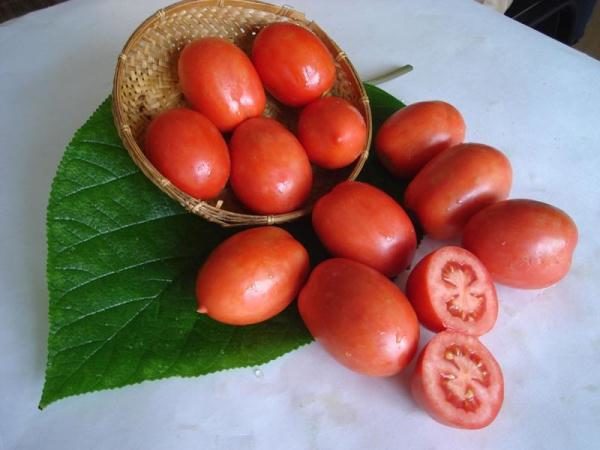

Shuttle - early ripe high-yielding tomato variety
Covered with a dense skin (no hardness), which has a positive effect on the transportation of fruits and good storage. Prevents fruit cracking. Growing weight outdoors varies from forty-five to seventy grams. Greenhouse performance is slightly higher.
Perfectly proven in all types of canning, especially in small containers... They are also used fresh: whole (children like them for their shape and size) and in salads (unobtrusive sweetish taste with a slight sour note).
Fruiting can continue until the onset of frost. For such medium-sized tomatoes, the yield is at a high level: at least five kilograms per square meter. And with proper care, you can collect all eight.
Determinant (undersized) early ripening variety with early onset of fruiting.
The distinctive property of cold resistance allows early planting in open ground, getting a harvest in the cool summer period. The variety is resistant to late blight.
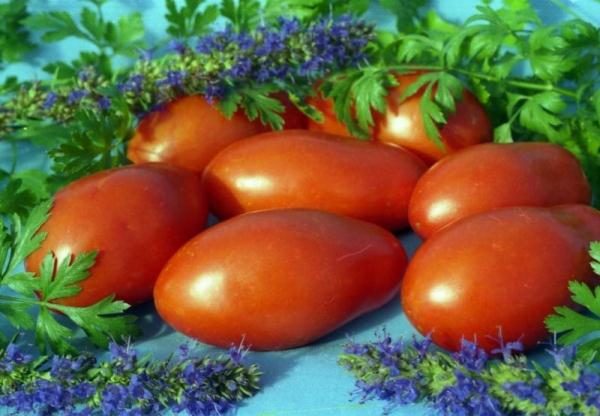

Tomatoes are universal, they are suitable for salads, side dishes, soups and sauces
The plant is represented by a bush with a low (up to 55 centimeters) strong stem. Compact with low branching, does not require garters, shaping and pinching. Suitable for growing in confined areas.
Inflorescences begin to appear after the seventh leaf. The onset of fruiting comes in the third month from the first shoots.
Many statements of people who wished to grow a shuttle speak for the conformity of the declared qualities. The compactness of a bush of a medium green massif does not require pinching or tying. It showed itself well in the Urals and in the West Siberian region... Inflorescences alternate with two leaves. High yield is present in the open field with long-term fruiting. The firmness of the fruit proved to be good for canning whole fruit in small jars (up to one liter).
Pros and cons of the variety
Like all crops grown, there are positive and negative points.
Pros:
- Early ripening fruits.
- Long-term storage no processing.
- Small fruit size contributes to the ease of winter blanks in small containers.
- Ease of growing, in the absence of favorable conditions.
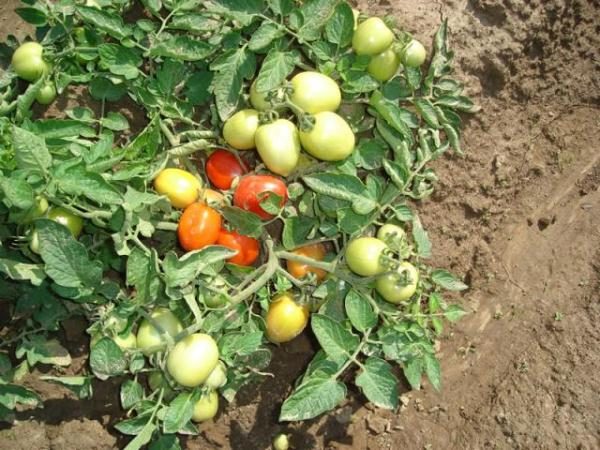

The Tomato Shuttle has a good yield.
Minuses:
- Weakly saturated scent.
- Taste does not dominate when consumed in processed form.
How to properly cultivate tomatoes
Cultivation is carried out by seedling method, from seeds. Usually the plant is planted in open ground from the end of spring, without delaying the process for a very long time (until the beginning of June). When planting seedlings, small amounts of wood ash are added to the soil, directly under the roots.
Now you need to figure out, observing what conditions it will be possible to grow a good crop of tomatoes.
Conditions for landing
Raise the varietal view should be through the seedlings. Chelnok tomatoes are not demanding in care. For the cultivation of this culture, general recommendations are still provided.
Landing dates
The seeds are sown from the end of February to mid-March. This is the most suitable time for the preparation of planting material (seedlings) for open cultivation with an early ripening period.
Where to plant the shuttle and what soil is needed
The place where the tomato garden will grow is prepared in the fall. The place is chosen with good lighting, ventilated, but in the absence of drafts... The plot is used after growing greens (parsley, dill), climbing crops (cucumbers, zucchini), root crops (carrots) or cabbage on it.
The difference between growing in a greenhouse and outdoors
Growing conditions in a greenhouse contribute to an increase in the growth of a bush with enlarged fruits.
The main purpose of the seedling method is obtained by early production. Sowing seeds on the street at a later period of time is also practiced.
Sowing shuttle for seedlings
Preparation begins with the substrate. For its preparation, sand with black earth is used in equal parts. Further, the lingering humus is mixed in a double amount. The seeds are slightly sunk into the prepared soil, wake up in a small peat layer, moisten... A film is stretched over the container with landings. The container is placed in a warm place. After a week, the first shoots will appear.
How to prepare seed
A 10 minute soak is used to disinfect the seed in a heated (slightly above body temperature) solution of aqueous hydrogen peroxide.
Choosing a container for planting
Here there are no restrictions on the use or prohibition on the use of any materialsused in the production of containers.
How to care for shuttle seedlings
Required regular ventilation of the mini greenhouse and control of the state of soil moisture... When dry, the surface is sprayed from a spray bottle. Before the emergence of shoots, the temperature regime is maintained up to 24 degrees Celsius. The next step is to remove the film over the sprouts, lower the degree column to around 16 in plus during the day, and 13+ at night. Watering is carried out with soft water.
Step-by-step picking of seedlings
It is carried out in individual containers (if planted in a common container) with the simultaneous removal of unformed shoots. First selection at the stage of unfolded cotyledonous leaf... Repeat with 3 - 4 main leaves.
Planting seedlings in open ground
Pre-hardening is carried out at +8 - +10 degrees outside the window. Duration up to one and a half hours. Warming up the earth to a dozen degrees signals the possibility of placing tomatoes in a permanent place.
Sowing scheme
Seedlings are planted up to four bushes per square meter with a distance between plants up to forty centimeters.
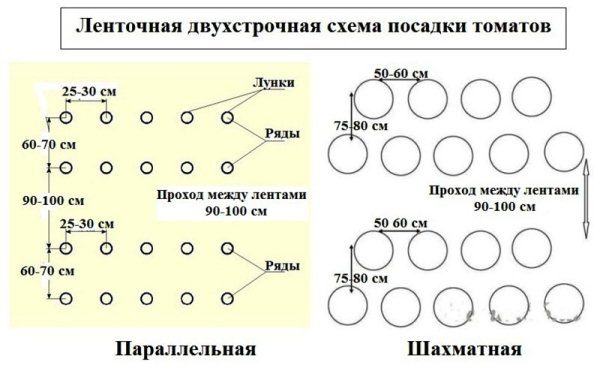

Planting scheme for tomato seedlings
The need remains in weeding, loosening, watering and feeding the planted crops.
How to water a plant
From the moment the bushes are planted on the street, watering is carried out in the operating mode once a week with moistening a quarter meter deep. With the formation and ripening of fruits, the amount of watering increases: for four plants three dozen liters.
Top dressing of tomatoes
Complex fertilizer is applied for the first time when planting seedlings. Further feeding is carried out at intervals of a week. Both organics and minerals are introduced. Each instance absorbs up to one liter of fertilizer.
Major pests and diseases
Late blight resistance does not guarantee safety against other common diseases. Possible damage by anthracnose tomatoes, powdery mildew. Most diseases come from fallen leaves and from weeds. Keeping the beds clean is an effective preventive measure.
Of the pests are dangerous: Colorado potato beetle, melon aphid, bear and spider mite. Soap solution will come to the rescue. For severe injuries, insecticides are used.
Harvest
Under favorable weather conditions, the first ripe tomatoes appear after three months from germination. Ripening occurs alternately, which provokes the maturation of the latter in the fall.... Good yields are possible even in the absence of a warm summer.
Suitable region and climate
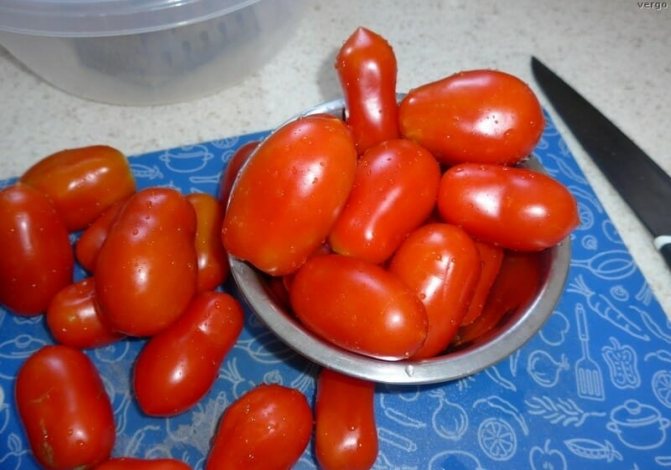

This variety was zoned in the Central (Moscow, Smolensk, Tula, Vladimir regions), Volgo-Vyatka (Nizhny Novgorod, Sverdlovsk regions, Perm Territory) and West Siberian (Kemerovo, Omsk, Tomsk, Novosibirsk regions, Altai Territory) regions.The variety is cold-resistant, so it can be cultivated in the northern regions.
It is grown both in open ground and in greenhouses. Tomato Shuttle grows well in central Russia. It is also cultivated in Ukraine, Belarus and Moldova.
Harvesting and application of the crop
Once the tomatoes are bright red and elongated, they are harvested. As a rule, ripening occurs in July and August, but continues even in autumn.
The tomatoes are plucked carefully so as not to damage either the branches or the fruit itself. For storage, the fruits are folded into a box covered with paper. It is not recommended to put too many tomatoes in one box, as the fruits lying underneath will be crumpled.
Store the box in a dry place, but not in direct sunlight. Indoors, the temperature should not exceed +6 degrees, otherwise the tomatoes will start to deteriorate. If there is a need for a long storage of tomatoes (more than 3 weeks), they are removed from the branches a little unripe and in the same way put in boxes to ripen.
The use of the crop is varied: the fruits are conveniently canned, they fit perfectly into jars. Tomatoes "Shuttle" will decorate the festive table even in the form of ordinary cuts.
Also, we must not forget about the beneficial properties of tomatoes. Tomatoes are a powerful antioxidant. Lycopene, which is part of the tomato, helps in the treatment of many diseases. In addition, tomatoes are antibacterial. Tomatoes also fight thrombosis, and due to the serotonin they contain, they raise the mood.


